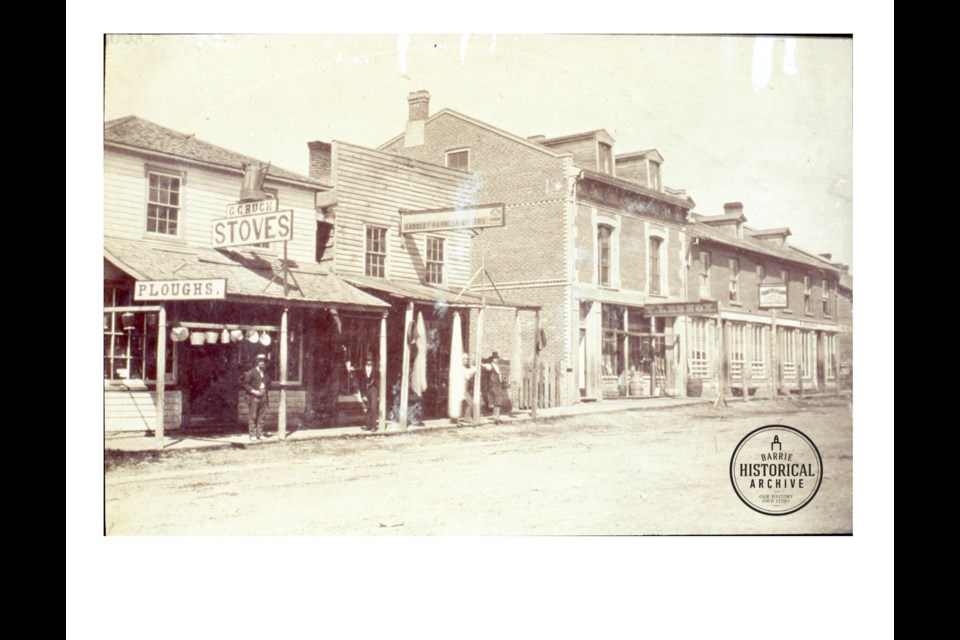In the early 1920s, the south side of Elizabeth Street, now called Dunlop Street West between Maple Avenue and Mary Street, must have been the most happening block in the downtown business district.
Charles Robinson was selling electric stoves and offering cooking classes to those inquisitive enough to try this modern innovation. Shiny new motor cars rolled out of VanPatter’s showroom and Hollywood was as close as the Capitol Theatre.
Certainly less glamorous, but yet another sure sign of the changing customs of 20th-century Canadians, was the beginning of a little funeral parlour that has grown and now served the community for nearly a century — 47 Elizabeth St. was the original location of the Steckley funeral business.
For many years in the not-so-distant past, a person was likely to die at home after being attended to there by the family doctor, and to perhaps have a wake and funeral held in the house as well.
A local undertaker would be called upon to build a coffin for the deceased and to transport the remains to the church and to the cemetery.
Usually, the undertaker was a carpenter by trade. His business of cabinet-making and wagon-building naturally progressed to include tending to the final needs of the local citizens.
One of the better known of these men was G.G. Smith who began his wood working venture in 1869 on Bayfield St., just north of Five Points, just about where the Ranch bar and restaurant is located today. Smith later crossed the street to the site of what was Steele’s China for many years.
The practice of embalming arose in North America during the American Civil War as many men died and families wished to have their remains transported home for burial. The trend gained widespread attention when President Abraham Lincoln was assassinated. His funeral train stopped in several cities over a period of two weeks in the spring of 1865, something that would not previously have been possible.
During these early times, doctors exclusively carried out this procedure. By the end of the 19th century, carpenters were increasingly adding care of the deceased body to their list of services, although it is difficult to envision a man trained in the crafting of wooden objects taking on such delicate and somewhat morbid task.
Later still, those offering this type of service began to prefer a more professional name such as mortician or funeral director as they sought to distance themselves from their tradesmen roots.
The next step came when funeral directors found that their customers were becoming interested in having all the arrangements conducted by a professional service. People were becoming less inclined to host wakes in their homes and some had no particular church affiliation at all to call upon.
Funeral directors usually maintained a house, where they lived with their family, and kept rather formal front parlour rooms for the use of the mourners’ needs.
In 1922, Oscar Reid began an undertaking business at 47 Elizabeth St. After one year, Percy Lloyd, a native of Oro Township, took over. He had served as an apprentice with the cabinet making and undertaking firm of Verney and Hay in Tottenham.
Walter Steckley joined Mr. Lloyd in 1938. Steckley was born in Whitchurch, Ont. and had spent his early career with Wright and Taylor in Richmond Hill. By the early 1940s, the business was officially known as Lloyd and Steckley.
Lloyd and Steckley remained at 47 Elizabeth St., until they outgrew the space in 1944. In September of that year, Lloyd and Steckley purchased a two-storey duplex residence on the northwest corner of Clapperton and Worsley streets. They completely renovated the interior to include a reception room, three large parlours, preparation rooms, laundry facilities, a freight elevator, a garage and a new electric organ. None of this would have been possible in the small space on Elizabeth St.
When Lloyd and Steckley removed their business to 30 Worsley St., Leighton A. ‘Hap’ Emms moved into 47 Elizabeth St., and conducted Emms Electric there for several decades.
In yet another odd juxtaposing of two very different types of employment, local athletic celebrity L.A. Emms was once described by the Barrie Examiner as “the electrical contractor who plays left wing for the Detroit Red Wings during the winter months.” True story.
Each week, the Barrie Historical Archive provides BarrieToday readers with a glimpse of the city’s past. This unique column features photos and stories from years gone by and is sure to appeal to the historian in each of us.



